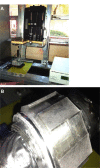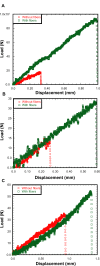Fracture toughness of titanium-cement interfaces: effects of fibers and loading angles
- PMID: 24729704
- PMCID: PMC3979689
- DOI: 10.2147/IJN.S59253
Fracture toughness of titanium-cement interfaces: effects of fibers and loading angles
Abstract
Ideal implant-cement or implant-bone interfaces are required for implant fixation and the filling of tissue defects created by disease. Micron- to nanosize osseointegrated features, such as surface roughness, fibers, porosity, and particles, have been fused with implants for improving the osseointegration of an implant with the host tissue in orthopedics and dentistry. The effects of fibers and loading angles on the interface fracture toughness of implant-cement specimens with and without fibers at the interface are not yet known. Such studies are important for the design of a long-lasting implant for orthopedic applications. The goal of this study was to improve the fracture toughness of an implant-cement interface by deposition of micron- to nanosize fibers on an implant surface. There were two objectives in the study: 1) to evaluate the influence of fibers on the fracture toughness of implant-cement interfaces with and without fibers at the interfaces, and 2) to evaluate the influence of loading angles on implant-cement interfaces with and without fibers at the interfaces. This study used titanium as the implant, poly(methyl methacrylate) (PMMA) as cement, and polycaprolactone (PCL) as fiber materials. An electrospinning unit was fabricated for the deposition of PCL unidirectional fibers on titanium (Ti) plates. The Evex tensile test stage was used to determine the interface fracture toughness (KC) of Ti-PMMA with and without PCL fibers at 0°, 45°, and 90° loading angles, referred to in this article as tension, mixed, and shear tests. The study did not find any significant interaction between fiber and loading angles (P>0.05), although there was a significant difference in the KC means of Ti-PMMA samples for the loading angles (P<0.05). The study also found a significant difference in the KC means of Ti-PMMA samples with and without fibers (P<0.05). The results showed that the addition of the micron- to nanosize PCL fibers on Ti improved the quality of the Ti-PMMA union. The results of the study are essential for fatigue testing and finite-element analysis of implant-cement interfaces to evaluate the performance of orthopedic and orthodontic implants.
Keywords: PMMA; cement; fracture toughness; interface; orthodontics; orthopedics; polycaprolactone; titanium.
Figures







References
-
- McCormack BA, Prendergast PJ. Analysis of crack propagation paths at implant/bone-cement interfaces. J Biomech Eng. 1996;118(4):579–585. - PubMed
-
- Orr JF, Dunne NJ, Quinn JC. Shrinkage stresses in bone cement. Biomaterials. 2003;24(17):2933–2940. - PubMed
-
- Kwong FN, Power RA. A comparison of the shrinkage of commercial bone cements when mixed under vacuum. J Bone Joint Surg Br. 2006;88(1):120–122. - PubMed
Publication types
MeSH terms
Substances
Grants and funding
LinkOut - more resources
Full Text Sources
Other Literature Sources

